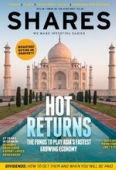Archived article
Please note that tax, investment, pension and ISA rules can change and the information and any views contained in this article may now be inaccurate.
Buying portfolio insurance

A large institutional buyer recently spent $120m on portfolio insurance to protect his clients against a market crash. The money has been used to purchase out-of-the-money call options on the VIX with the investment representing about 8.5% of the open interest in these contracts.
The VIX or Chicago Board Options Exchange Volatility Index measures market expectations of short-term volatility by looking at the prices of a wide range of options on the S&P 500.
If there was a stock market crash it would cause a spike in volatility that would result a sharp rise in the VIX and the value of the associated call options. The index is currently trading close to record lows at just over 10, but briefly closed at 28 last February when Chinese economic growth fell to a 25-year low.
It is thought that the buyer was Ruffer LLP, an investment management firm that looks after money for private clients and institutions, as well as running a range of funds including defensive multi-asset mandates such as CF Ruffer Total Return (GB0009684100) and the Ruffer Investment Company (RICA).
Buying the VIX
Most private investors would not be able to buy the call options, but there are a handful of US-listed exchange traded products linked to the VIX that could provide short-term insurance. These include the iPath S&P 500 VIX Short Term Futures ETN (VXX) and the ProShares VIX Mid-Term Futures ETF (VIXM).
VXX provides exposure to a daily rolling long position in the first and second month VIX futures contracts. It has just under $1bn in assets under management and is structured as an Exchange Traded Note (ETN), which is an unsecured debt security issued by Barclays Bank plc.
VIXM tracks the S&P 500 VIX Mid-Term Futures Index, which measures the returns of a portfolio of monthly VIX futures contracts with a weighted average of five months to expiration. The ETF has $38m of assets under management and has a negative correlation to the S&P 500, but it does not closely track the VIX.
Russ Mould, investment director at AJ Bell, says that it is not possible to invest directly in the VIX, so these products look to follow VIX futures.
‘Futures expose investors to the roll – once a futures contract ends it has to be rolled over and if the market is in contango (the future price is higher than the current, spot price) then the trackers have to sell cheaper short-dated futures and buy more expensive longer-dated ones. Over time this will create downward pressure on the price and performance.’
He cites the example of VXX, which since inception in 2009 is down in price by 99.95%, while the VIX itself has fallen by 78%.
‘I am not sure that such tools are at all suitable or appropriate for private investors. If you don’t understand or like the sound of any of the technicalities, you shouldn’t even consider using this sort of instrument.’
'Investors with sufficient experience, knowledge and risk appetite could explore the use of Inverse ETFs, which make money when the relevant index falls.'
Other ways to protect your portfolio
Adrian Lowcock, investment director at Architas, says that the best thing to do is to be well diversified, as having exposure to ‘safe haven’ assets such as gilts reduces the impact of a correction.
‘Gold is another asset class that is considered a safe haven asset, whilst there are some absolute return funds that look to deliver a return above cash and protect on the downside.’
He suggests the iShares Physical Metals plc Physical Gold ETC (SGLN), which holds physical gold, and Newton Real Return (GB0001642635), where the manager’s first priority is capital protection, with the secondary objective being to deliver returns of 4% above cash per annum over the longer term.
Martin Bamford, MD of Informed Choice, Chartered Financial Planners, says that in the current economic environment, risk reduction through diversification is harder to come by.
‘Investors with sufficient experience, knowledge and risk appetite could explore the use of inverse ETFs, which make money when the relevant index falls. One example is the db x-trackers FTSE 100 Short Daily ETF (XUKS), although I would not recommend these holdings for anyone other than professional investors.’
Darius McDermott, MD of Chelsea Financial Services, suggests Henderson UK Absolute Return (GB00B5KKCX12) and Smith & Williamson Enterprise (IE00B5NY4X40), both of which are ‘long/short’ targeted absolute return funds that invest in UK companies.
‘Historically the Henderson fund has been around a third to a half as risky as the UK stock market. The Smith & Williamson fund has been designed to be about half as volatile as the UK equity index, providing equity-like performance but with fewer ups and downs.’ (NS)
Important information:
These articles are provided by Shares magazine which is published by AJ Bell Media, a part of AJ Bell. Shares is not written by AJ Bell.
Shares is provided for your general information and use and is not a personal recommendation to invest. It is not intended to be relied upon by you in making or not making any investment decisions. The investments referred to in these articles will not be suitable for all investors. If in doubt please seek appropriate independent financial advice.
Investors acting on the information in these articles do so at their own risk and AJ Bell Media and its staff do not accept liability for losses suffered by investors as a result of their investment decisions.

 magazine
magazine








